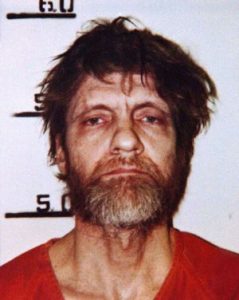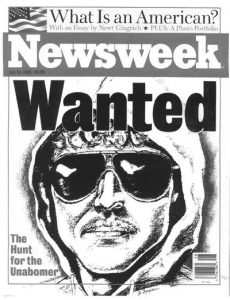 Ted Kackynski
Ted Kackynski
– Country: UNITED STATES
– Dates: 1978 (first bomb) – 1996 (detention).
– Description of the case
One of the most complicated manhunts in US history and one of the most expensive too (it costed about $ 50 million).
Theodore Kaczynski was a gifted student; he was admitted in Harvard at the age of 16. He worked as a university professor of mathematics until he made enough money to buy a piece of land in the wild and move there on its own. He lived without a car, without electricity, running water or any “modern” things, since he was against all of that. He wanted to get rid of the industrial system, so he lived according to his morals and ideals.
He planted bombs in the US for 17 years, with 16 attacks in total, on Universities and Airlines. That’s why he was given the name “Unabomber” by the FBI, as he was a “University and airline bomber“. Three people were killed and dozens injured. He signed the letters he sent to the authorities and the bombs with FC “Freedom Club”.
The bombs were planted in areas between Chicago, Utah and North Carolina, so the FBI investigators had a starting point to begin with: he must have known those areas in advance and he probably lived nearby. And they were right.
However, they thought that he was an airline worker and that was why he chose the airlines for the bombs, but they were not right there. They changed their minds when they received the Manifesto, sent by the Unabomber to the New York Times, who turned it over to the FBI. In this 35.000-word essay, entitled “Industrial society and its future” he talks about the rejection of technology and modern society. Moreover, one of the times that he went out to send the bombs, a woman saw him and gave a description to the police that would become a very famous sketch of the man.
 The famous sketch
The famous sketch
That was almost all the information there was about the case for a long time, until the so-called “Unabomber Manifesto” was published, which would be the beginning of the end, since he had unknowingly turned himself in through language.
At first, the linguistic evidences were not easily accepted by the forensic community, but they were accurate and delimited the personality of the subject, something that the FBI could not do before in the previous 16 years. Thus, when a certain type of people began to be delimited (they already knew that it had to be a male person, white, at least 50 years old, with a doctorate between the years 67 and 72 and a dissertation), they began to pay more attention to forensic linguistics.
Even so, everything changed when the Unabomber decided to negotiate. He sent a letter to the main newspapers and media where he assured that he would stop the bombs if the newspapers published his manifesto. They decided to publish it as it was a good way for people to read it and maybe someone would recognize the way he expresses himself and his ideas.
Although there was a very expensive and unsuccessful attempt to catch him, where a lot of agents and resources were used (being one of the most expensive manhunt operations in America), but they didn’t get what they wanted.
However, when the manifesto was published, it was read by Linda Patrik, David Kaczynski’s wife, Ted Kaczynski’s brother, also known as the Unabomber. His brother saw him as a hero and he never thought it could be him, but when he read the manifesto, he realized that many of his ideas and ways of expressing himself were familiar to him. In the end he accepted to tell the FBI about their suspicions. It was the beginning of the end for the Unabomber.
They sent one of his writings to the FBI, where they analysed his style and language, concluding that it was him. They had discovered the Unabomber, and all because of his use of language. They obtained sufficient evidence from the letters that Ted sent to his brother, which the latter gave to the FBI agents, who analysed them to see the similarities between the language used in them and the language used in the manifest.
They found him. They used these evidences to convince the superiors in charge of this case, to be able to request an order to go to the cabin where Ted lived, and there discover the truth. They went, and found materials related to the making of the bombs, as well as his writings for more than 20 years as a diary, and versions of the manifesto. Thus, the Unabomber was hunted, and forensic linguistic was introduced as a legal discipline.
Nowadays, he is still in jail, where he is sent an enormous number of letters monthly from many people who identify with him or who support him and his way of thinking. He has never been in a romantic relationship, perhaps one of the reasons all this happened. If you have people who love you and support you, you don’t feel so alone and misunderstood. For a short period of time, he was being visited by a journalist with whom he fell in love, and it was mutual. However, she was told that she had cancer and shortly after that she died, something very sad as it could have been very beneficial for Ted.
“But who was he really? What was he like? We are told to remember the idea, not the man, because a man can fail. He can be caught, he can be killed and forgotten, but 400 years later, an idea can still change the world. I’ve witnessed first hand the power of ideas, I’ve seen people kill in the name of them, and die defending them […] ” (McTeigue, 2006)
I have chosen that quote from V for Vendetta, since I think they are very similar stories. In both we have a man fighting for his ideals, doing it in an unconventional way (both are terrorists who plant bombs). They both tell their truth and fight to defend it, but choose the wrong way to do it. Both feel misunderstood, although the story of V for Vendetta is fictitious, although the character is influenced by Guy Fawkes (a real person, one of the members of the group that tried to assassinate the king in the so-called “Gunpowder Plot”). Both stories are questioned even today, there are people who see them as heroes, and others who see them as terrorists. Fortunately, each one of us can choose what to think or believe.
– Materials/Documents examined in the case
The main elements used in this case were the letters he wrote to the newspapers as well as the manifesto, named “Industrial Society and Its Future by FC” that would be known as the “Unabomber Manifesto”.
Moreover, when Ted was identified as the main suspect, his brother provided a lot of letters that Ted had been sending him over the years, so they were analysed too.
– Linguist(s) involved: James R. Fitzgerald, a (now retired) FBI agent, criminal profiler, forensic linguist and author.
 FBI agent James R. Fitzgerald
FBI agent James R. Fitzgerald
– Analysis of the language, evidences and methodology used to solve the case.
Analysing the Manifesto, the FBI investigators realised that in he was giving away clues about his identity through his way of using the language (without him noticing that). Therefore, now we are going to talk about the linguistic aspects that were analysed in the case and the conclusions they reached
An example of his particular way of writing is in is in paragraph 185: “you can’t eat your cake and have it too”. (Kaczynski), 2009, p. 70) It is a popular saying, but the thing is that it is backwards, as one would say “you can’t have your cake and eat it too” but not in the way the Unabomber wrote it, as it doesn’t make much sense that way.
Moreover, in paragraph 11: he uses words like “negro”, “broad”, “chick”. They realised he was using words that no young people would use, as they are generational, they are not used by people younger than 40 years old. So, according to that, he had to be older. The fact that he used “negro” was a clue that he wouldn’t live in San Francisco per se, or else he wouldn’t be using that word (as the big part of that city are Afro-Americans and it is not something you say in front of them, so he hasn’t been surrounded by black people in the place he lives). However, the packages were sent from San Francisco, so that could express that maybe he is near that area and he goes there to send them. (Kaczynski), 2009, p. 7)
They also started investigating his style to discover where did it come from. They discovered it was from the Chicago Tribune, so he grew up in Chicago and learnt the spelling there.
In his text, he uses long sentences, a formal style and he tries to sound smart (maybe that is because he is smart and not because he is pretending to be so). He uses weird words but they are not spelling mistakes, they are just written differently (like “analyze” with “s”, “willful” with one “l”, …), also he has numbered paragraphs, citations, etc. In short, they realized he was using a weird format.
Because of the elections of words: he used “corrections” instead of “errata” in Latin, that gave away, along with the numbered paragraphs, the numbered end notes and the corrections page, that the format was a style of dissertation, used before 1972, as they changed the format after that, and also the corrections page was called errata before 1967.
This style was exclusively used by PhD candidates, so if he was using it 20 years later, he must have had written one dissertation between 67 and 72.
Years after the Unabomber was captured, Fitzgerald spoke to a newspaper where he said the following, answering to a question about what had been the first errors he saw in the manifesto: “The first three pages have smudges, but since he used a typewriter from 1932 that did not have the delete key, he had to make the corrections by hand. I felt that these rather small errors were telling me something, I did my research and realized that theses or dissertations from the 30s to the 60s had similar corrections. That gave me a little idea of his age and we correct it in the initial profile. We also learned that he was a person with advanced studies”. (El Comercio, 2018)
After a careful analysis of the texts available to the FBI, approximately 14, including the Manifesto. Some of the main results were: The Unabomber made practically no mistakes when writing. Also, the format was typical of an academic thesis. Each paragraph was numbered, and there were footnotes and bibliographic references at the end of the chapter. Moreover, in the Manifesto he underlined some words and phrases, which undoubtedly revealed that they were important to him. There was also importance in the fact that some of the most distinctive words and phrases in the writing were “chimerical,” “middle-class emptiness,” and above all, “coolheaded logician”. This was of vital relevance because when his brother David read the manifesto, he saw that word and recognized that it is something his brother used to say. Related to this, the content analysis showed the high frequency of certain words, such as “society” (254 times), “power” (234), “technology” (198) and “freedom” and / or “autonomy” (125). (Garrido, 2011, p. 99)
They realised that in the manifesto, there is also value in the things he doesn’t talk about, so they can know more about him. He doesn’t talk about family, wife, friends, so he probably doesn’t have one or he is not very attached to that kind of things. He doesn’t talk about work either, so probably he doesn’t have one or that doesn’t matter to him. He is against electronics so he doesn’t have a TV, or a computer, he doesn’t know about pop culture or anything modern, he is out of society. He is not close to black people, women or children. He is probably someone isolated. They got that just by the way he wrote about people and his thoughts about the modern technological society.
When his brother provided the letters that Ted was sending him, a comparative analysis of them was carried out, where all the letters were analysed to find similarities with the Unabomber documents, especially the manifesto. One of the key aspects was that in one of the letters, Fitzgerald recognized the expression “We cannot eat the cake and have it too”, something that the Unabomber had already written before and that caught his attention, as it was one of the few errors that he had. (Garrido, 2011, p. 101)
For the trial, the FBI agents presented a document with a comparative analysis of the documents they had, the ones sent by the Unabomber and also the documents provided by the family of Ted Kaczynski. They did it by columns, in one part they put expressions, ideas and words they found in the documents the Unabomber sent the FBI or the newspapers, and in the other they put the same expressions, ideas and words used in the documents the family of Ted Kaczynski provided to the FBI. And that was convincing enough as evidence for the judge to give the order to search Ted’s house, where they found the material evidence that ended up giving him away.
– Conclusion
So, here ends the case of the Unabomber, Ted Kaczynski, who terrorized the United States for 17 years, until in the year 1996 they discovered his identity thanks to the linguistic evidence found and defended by the FBI agent James R. Fitzgerald and thanks also to the help of Ted’s brother, who provided further writings and the address where his brother was. Was he a terrorist? Yes. Was he right? Probably yes, at least for some people.
However, we are not here to discuss that, but to talk about the language. This was a crucial case in the history of forensic linguistics. The discipline began to be accepted thanks to this event. Without it, the case could not have been solved. Language is a key evidence, as it is something that we all use, orally and in writing, and that says much more about us than we think. When we express ourselves, we are delimiting our socio-individual and socio-collective profile, that is, we give clues about who we are and what surrounds us, so we have to be very careful every time we speak, because it could turn against us.
Bibliography
El Comercio, R. G. (April, 2018). Agent who captured the ‘Unabomber’: “I spent 10 hours a day reading his manifesto”. El Comercio.
Garrido, V. (2011). Perfiles criminales: un recorrido por el lado oscuro del ser humano. (Criminal profiles: a journey through the dark side of the human being). Ariel.
Grogan, M. (Direction). (2020). Unabomber: In His Own Words [Documentary].
Kaczynski), F. (. (2009). Industrial Society and its Future (The Unabomber Manifesto). Livermore, California, United States of America: WingSpan Press.
McTeigue, J. (Direction). (2006). V for Vendetta [Movie].
Reelz (Direction). (2020). The Lost Unabomber Tapes [Documentary].
Sodroski, A. (Direction). (2017). Manhunt: Unabomber [TV series].
– Links to websites with additional information on the case:
https://daily.jstor.org/fighting-words-unabomber/
https://www.britannica.com/biography/Ted-Kaczynski
https://www.history.com/topics/crime/unabomber-ted-kaczynski#section_4
https://www.fbi.gov/history/famous-cases/unabomber
https://www.theguardian.com/world/2009/sep/15/my-brother-the-unabomber
– The case in popular culture
Unabomber: In His Own Words [Docuseries]. Grogan, M. (Director). (2020).
The Lost Unabomber Tapes [Mini Series]. Reelz (Director). (2020).
Manhunt: Unabomber [TV Series]. Sodroski, A. (Director). (2017).
Leave a Reply